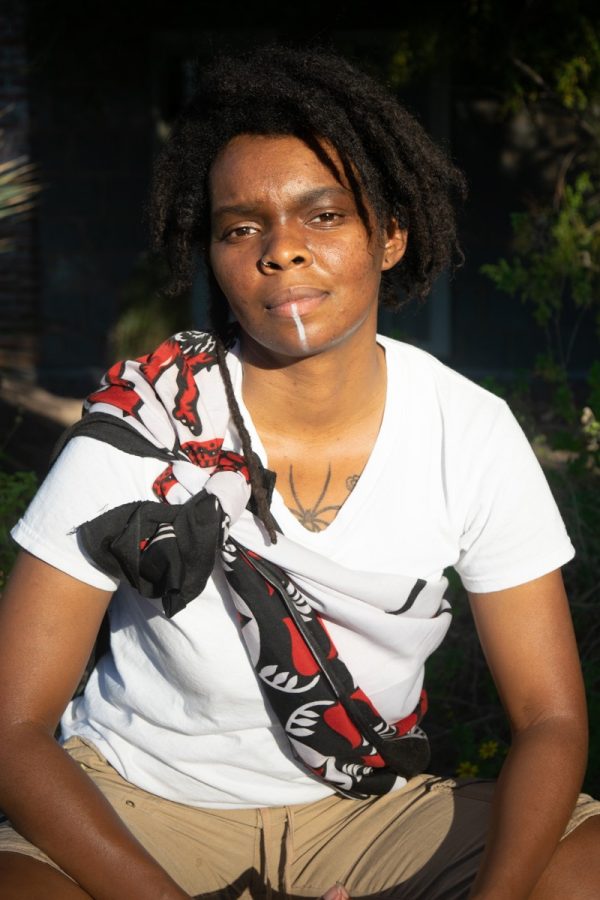The moment that artist Tyrell Blacquemoss sat down to speak with me, a wave of calm crashed over me. With a soothing voice dripping with wisdom, Blacquemoss’s grounded, creative spirit took me on a journey as they gave me a glimpse into an art form I had never even considered: the art of dreams.
Tyrell Blacquemoss is a Sangoma traditional healer, cross-cultural shamanic practitioner and artist currently based in Tucson as they work towards their MFA at Prescott collage. Their most recent project entitled Diasporic African Dream Anthology — or DADA — went live in July and features the work of 10 artists curated into a digital anthology that explores Indigenous African dream ways.
Blaquemoss grew up in Kenosha, Wisconsin, where their journey as an artist began.
“I started as a kid. I was always drawing a lot and thinking and contemplating a lot,” Blacquemoss said.
While receiving a BFA with an emphasis in Africana and Indigenous studies at Cornell University, Blacquemoss began to find theirself as an artist.
“I think my art really changed when I was in undergrad because I also started studying herbalism and I started doing community organizing,” Blaquemoss said. “I was also studying Africana studies and Indigenous studies while I was in art school, so it really opened up a way to think about art that really engaged people, really engaged landscape.”
RELATED: COBA left feeling unprioritized after meeting with administration
Blaquemoss’s identity and cultural background drives them as an artist.
“My identity is very fluid and multi-faceted. I’m Black, I’m queer, I’m trans. I’m very very spiritual; I’m an initiated Sangoma, which is a South African traditional healer,” Blacquemoss said. “I think my calling as a Sangoma really focuses my work to help me understand that everything that I do needs to be towards Black Indigenous sovereignty.”
Building on this identity, Blaquemoss curated DADA.
As explained on the DADA website, “DADA is a digital exhibition and ceremony space of visual, literary, and oral history weaving of Indigenous African dream practices moving through time, space, and diaspora, offering refuge, solace, and solutions to our present experiences.”
Blaquemoss said that the creation of DADA came out of a three-day long dream they had.
“The dream was to create a biennial that exists in multiple places around the world,” Blacquemoss said. “And it really centers African and Indigenous knowledge as foundational of all these other knowledges that happened afterward.”
Blaqumoss explained that DADA is a smaller version of that dream and works to lay foundations to organize something that big.
DADA is broken down into three parts: Diasporic African Dream Anthology, Matriarchal African Memory Apparatus and African Legacy Lingers. While DADA is the actual exhibition itself, MAMA and ALL invite audience members to participate in the dream anthology and bring the project into the community to inspire change.
RELATED: Local Tucson gallery celebrates folklore and folktales with October exhibition
MAMA aims to collect memories of dream stories from audience members.
The DADA website states, “MAMA is an oral history preservation and intention of Matriarchal African Memory Apparatus. An ode to the mitochondrial DNA that tells of our roots. Oral history will be collected through writing and recordings from the audience members regarding their dream practices and responses to the exhibition. Be brave and join us in this remembering.”
ALL is the last aspect of the project and focuses on community outreach in hopes of spurring positive change.
“What we want to do is create round tables and opportunities for the community to say, ‘these are the people in our communities who are living closest to the earth,'” Blacquemoss said. “The folks who are homeless, the Indigenous folks, the folks who are marginalized in multiple ways. Let’s really listen to them and see where they need this money in this community to go.’’
The end goal of DADA is to ultimately distribute $1 million across several United States cities to communities that are in need and living closest to the earth.
“When you support the people who are living closest to the earth you are also supporting the earth,” Blacquemoss said.
RELATED: Business owners reflect on cancellation of Fourth Avenue’s Winter Street Fair
In addition to the DADA project, Blacqumoss also leads a DREAM school which stands for Dream Reclamation, Energy and Ancestral Healing and Matriarchal Praxis.
“I teach people how to dream with their ancestors,” Blacquemoss said.
“That’s the beauty of following dream stuff, without even knowing what’s coming you can anticipate and be ready,” Blacquemoss said. “Because your ancestors do know what’s coming. They don’t exist in this physical realm, they exist in a realm where time is collapsible and they can see the things that are coming in a way that us in human bodies can’t necessarily see and engage with”.
Blacqumoss stressed the importance of listening to those who are connected with the spiritual realm during this time of social reckoning we find ourselves in.
“You really need to be supporting Black, trans, queer, indigenous artists,” Blacquemoss said. “Because we are connected to the spiritual realms, we are connected to climate change grief, we are constantly looking at systems. Therefore you should be using more artists as you think about systems change and rebuilding systems.”
If you would like to view the exhibition or learn more about DADA, visit the DADA website at www.causereign.com/dada.
Follow Tia Stephens on Twitter















